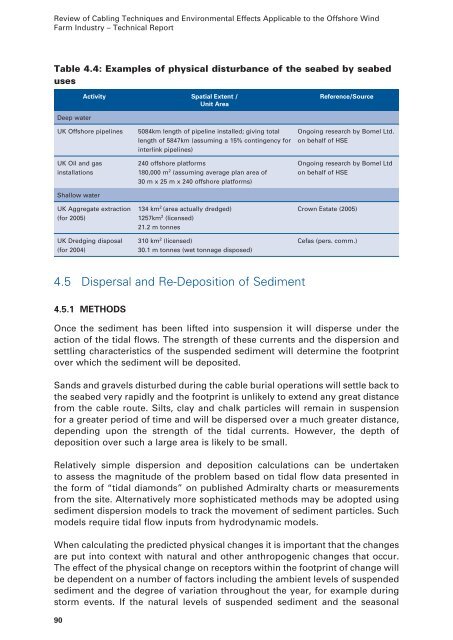Review of Cabling Techniques and Environmental Effects Applicable
Review of Cabling Techniques and Environmental Effects Applicable
Review of Cabling Techniques and Environmental Effects Applicable
You also want an ePaper? Increase the reach of your titles
YUMPU automatically turns print PDFs into web optimized ePapers that Google loves.
<strong>Review</strong> <strong>of</strong> <strong>Cabling</strong> <strong>Techniques</strong> <strong>and</strong> <strong>Environmental</strong> <strong>Effects</strong> <strong>Applicable</strong> to the Offshore Wind<br />
Farm Industry – Technical Report<br />
Table 4.4: Examples <strong>of</strong> physical disturbance <strong>of</strong> the seabed by seabed<br />
uses<br />
Deep water<br />
90<br />
Activity Spatial Extent /<br />
Unit Area<br />
UK Offshore pipelines 5084km length <strong>of</strong> pipeline installed; giving total<br />
length <strong>of</strong> 5847km (assuming a 15% contingency for<br />
interlink pipelines)<br />
UK Oil <strong>and</strong> gas<br />
installations<br />
Shallow water<br />
UK Aggregate extraction<br />
(for 2005)<br />
UK Dredging disposal<br />
(for 2004)<br />
240 <strong>of</strong>fshore platforms<br />
180,000 m 2 (assuming average plan area <strong>of</strong><br />
30 m x 25 m x 240 <strong>of</strong>fshore platforms)<br />
134 km 2 (area actually dredged)<br />
1257km 2 (licensed)<br />
21.2 m tonnes<br />
310 km 2 (licensed)<br />
30.1 m tonnes (wet tonnage disposed)<br />
4.5 Dispersal <strong>and</strong> Re-Deposition <strong>of</strong> Sediment<br />
4.5.1 METHODS<br />
Reference/Source<br />
Ongoing research by Bomel Ltd.<br />
on behalf <strong>of</strong> HSE<br />
Ongoing research by Bomel Ltd<br />
on behalf <strong>of</strong> HSE<br />
Crown Estate (2005)<br />
Cefas (pers. comm.)<br />
Once the sediment has been lifted into suspension it will disperse under the<br />
action <strong>of</strong> the tidal flows. The strength <strong>of</strong> these currents <strong>and</strong> the dispersion <strong>and</strong><br />
settling characteristics <strong>of</strong> the suspended sediment will determine the footprint<br />
over which the sediment will be deposited.<br />
S<strong>and</strong>s <strong>and</strong> gravels disturbed during the cable burial operations will settle back to<br />
the seabed very rapidly <strong>and</strong> the footprint is unlikely to extend any great distance<br />
from the cable route. Silts, clay <strong>and</strong> chalk particles will remain in suspension<br />
for a greater period <strong>of</strong> time <strong>and</strong> will be dispersed over a much greater distance,<br />
depending upon the strength <strong>of</strong> the tidal currents. However, the depth <strong>of</strong><br />
deposition over such a large area is likely to be small.<br />
Relatively simple dispersion <strong>and</strong> deposition calculations can be undertaken<br />
to assess the magnitude <strong>of</strong> the problem based on tidal flow data presented in<br />
the form <strong>of</strong> “tidal diamonds” on published Admiralty charts or measurements<br />
from the site. Alternatively more sophisticated methods may be adopted using<br />
sediment dispersion models to track the movement <strong>of</strong> sediment particles. Such<br />
models require tidal flow inputs from hydrodynamic models.<br />
When calculating the predicted physical changes it is important that the changes<br />
are put into context with natural <strong>and</strong> other anthropogenic changes that occur.<br />
The effect <strong>of</strong> the physical change on receptors within the footprint <strong>of</strong> change will<br />
be dependent on a number <strong>of</strong> factors including the ambient levels <strong>of</strong> suspended<br />
sediment <strong>and</strong> the degree <strong>of</strong> variation throughout the year, for example during<br />
storm events. If the natural levels <strong>of</strong> suspended sediment <strong>and</strong> the seasonal
















